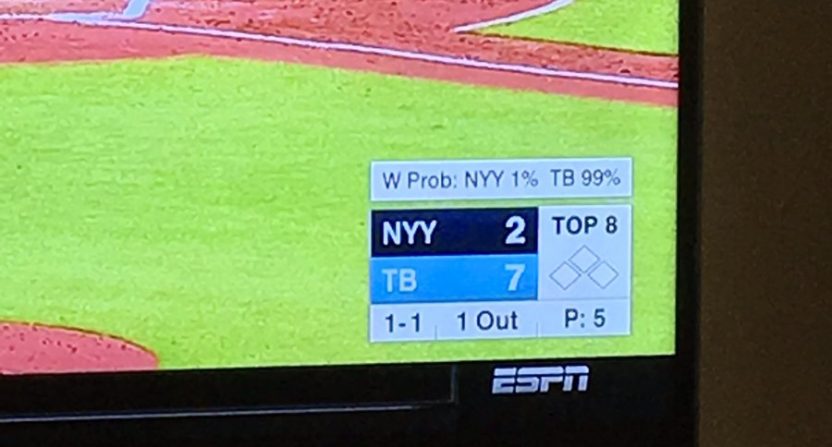ESPN debuted a new feature during its MLB Opening Day broadcasts Monday, and like every subtle change to every broadcast ever, a lot of fans instinctively disliked it.
The feature in question was a little graphic in the bottom-right corner of the screen explaining each team’s win probability in the current game.
https://twitter.com/Joe_TOC/status/848624907684630529
Reviews for showing win probability on screen were pretty unanimously negative, with fans complaining that the concept is un-fun, annoying or misleading.
The win probability graphic/discussion on ESPN is literally taking a sword and sticking it through the chest of any fun left in baseball
— Kenny Ducey (@KennyDucey) April 2, 2017
Hey ESPN, I guess I'm OK with you showing a win probability graphic late in a ballgame. But in the second inning, when it's scoreless? Nah.
— Dan Kolko (@masnKolko) April 3, 2017
I can already tell the win probability numbers ESPN flashes occasionally above the scoreboard is going to annoy me all year
— Mike Peasley (@PeasRadio) April 3, 2017
Hey @espn, what's the win probability in a 0-0 game in the 3rd of 1/162? THE PEOPLE NEED TO KNOW. (Wait what? NO ONE needs to know? Oh.)
— Matt Grondin (@matteegee) April 3, 2017
Someone get screengrabs of ESPN feeding the lopsided win probability down our throats please
— Stan (@Crewsett) April 3, 2017
https://twitter.com/jr19815/status/848750732404830214
https://twitter.com/T_Strunk/status/848716507425189893
Hey @espn, that win probability stat is idiotic. Please stop showing it during baseball games, it literally means nothing. Thanks
— Louis Acklin (@lacklin12) April 3, 2017
https://twitter.com/WSChamps2016/status/848739859825135618
https://twitter.com/M_D_Hansen/status/848750071600603136
https://twitter.com/BigSean_6/status/848747292299603968
This is why the cute little "win probability" thing ESPN kept showing last night is so meaningless.
— Matt Saunders (@citylifematt) April 3, 2017
Who else is thinking this about the "Win Probability"? pic.twitter.com/LuWaICPGUR
— Joey (@AGuyNamedJoey) April 3, 2017
In an unfortunate twist for ESPN’s win probability, the Cubs scored three runs against the Cardinals in the ninth inning Sunday night to flip what had been something like a 97-3 St. Louis edge into a toss-up.
Though the Cardinals ended up winning in the bottom of the inning, for people who don’t fully understand how statistics work the Cubs’ comeback was proof that win probability was worthless.
How's that 3% #Cubs "Win Probability" look right about now? Lol #ESPN #GoCubsGo
— Robert-Critical Handsome Theory🇦🇷 (@ikeman53) April 3, 2017
https://twitter.com/nswenso/status/848745583363764225
WHATS MY WIN PROBABILITY NOW ESPN YOU CHODES
— Matthew Carl Barnard (@matthewcbarnard) April 3, 2017
ESPN has to cut the shit with this win probability %. Cubs were 2% in game 7 and came back to win. That % doesn't matter in baseball
— maybe: ryan (@rcnoswag) April 3, 2017
Win probability can be a cool stat to look at after a back-and-forth game or dramatic comeback to show how dramatically the odds swung, but it does feel a little meaningless in real time. What exactly are we gaining from knowing the Astros have a 56 percent chance of winning the game when it’s 3-1 in the fourth? And if the win probability is 98-2 in the late innings, what are you suggesting? That we turn off the game?
For teams, win probability could be be extremely useful, indicating the leverage of a given moment (although, leverage index does that better) and therefore helping managers decide which pitcher to insert or whether to pinch run. For fans, it’s knowledge for the sake of knowledge. At worst, it diminishes the game’s excitement. At best, it doesn’t do much of anything.







